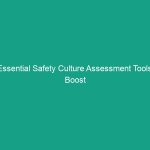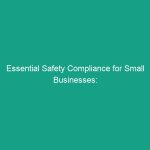Good Morning Team!
Today, we’re diving into an essential topic: Essential Guidelines to Prevent Workplace Violence. Workplace violence can take many forms, from verbal abuse to physical altercations, and it’s crucial that we understand the risks and how to mitigate them. By the end of this Toolbox Talk, you’ll have practical tips that can help create a safer work Environment for everyone.
Understanding Essential Guidelines to Prevent Workplace Violence
Workplace violence refers to any act of violence or harassment that occurs in a work setting. This can include threats, verbal abuse, physical assaults, and even homicide. The importance of preventing workplace violence cannot be overstated; it affects not only the Safety of our employees but also the overall productivity and morale of the workplace.
Many people believe workplace violence is rare or only happens in certain industries, but the truth is that it can happen anywhere. Understanding the scope and seriousness of this issue is the first step in Prevention.
Key Hazards, Risks, and Safety Considerations
Identifying the Hazards associated with workplace violence is crucial in prevention efforts. Some of the key factors include:
- High-stress environments: Workplaces where employees face high pressure may experience increased tension and conflict.
- Unclear job roles: Ambiguity in job responsibilities can lead to misunderstandings and conflicts.
- Inadequate Training: Employees who are not trained to handle conflict may escalate situations instead of resolving them.
The consequences of ignoring these factors can be severe. They can lead to injuries, lost workdays, decreased productivity, and a toxic work culture. It’s essential to address these hazards proactively.
Best Practices, Procedures, & Actionable Advice
To prevent workplace violence, it’s important to follow specific Procedures and practices. Here are some actionable tips you can implement immediately:
1. Establish Clear Policies
Develop a clear workplace violence policy that outlines unacceptable behaviors and the consequences for engaging in them. Ensure every employee understands this policy.
2. Provide Training
Regular training sessions can equip employees with conflict resolution skills and the knowledge to identify warning signs of potential violence. Consider role-playing scenarios to practice responses.
3. Foster Open Communication
Encourage employees to speak up about their concerns. Establish a system for reporting incidents or threats without fear of retaliation. This could foster a culture of trust and safety.
4. Create Safe Workspaces
Design the workplace to minimize risks. This might include maintaining proper lighting, ensuring clear exit routes, and having security measures in place, such as surveillance cameras or security personnel.
5. Encourage Team Building
Promote activities that build teamwork and camaraderie among employees. A positive workplace culture can reduce misunderstandings and conflicts.
6. Real-World Example
Consider a scenario where a disagreement escalated into a physical altercation due to lack of communication and unresolved tension. After implementing training and conflict resolution policies, the company reported a significant decrease in incidents, highlighting the effectiveness of proactive measures.
Regulations, Standards, and Compliance
It’s essential to be aware of relevant Regulations regarding workplace violence. Organizations like OSHA have guidelines that require employers to provide a safe work environment, which includes preventing workplace violence. Compliance with these regulations not only protects employees but also shields the organization from legal repercussions.
Employee Engagement & Discussion
Now, let’s open the floor for discussion. What safety challenges have you encountered related to workplace violence? How can we improve our current practices? Sharing experiences can help us learn from one another and strengthen our preventive measures.
Conclusion & Key Takeaways
To wrap up, workplace violence is a serious issue that requires our collective attention and action. By understanding the guidelines, recognizing the risks, and implementing Best Practices, we can foster a safer environment for all. Remember, safety is a shared responsibility, and every one of us plays a vital role in preventing workplace violence.
Thank you for your commitment to safety and for participating in today’s Toolbox Talk. Let’s work together to ensure our workplace remains safe and welcoming for everyone!


